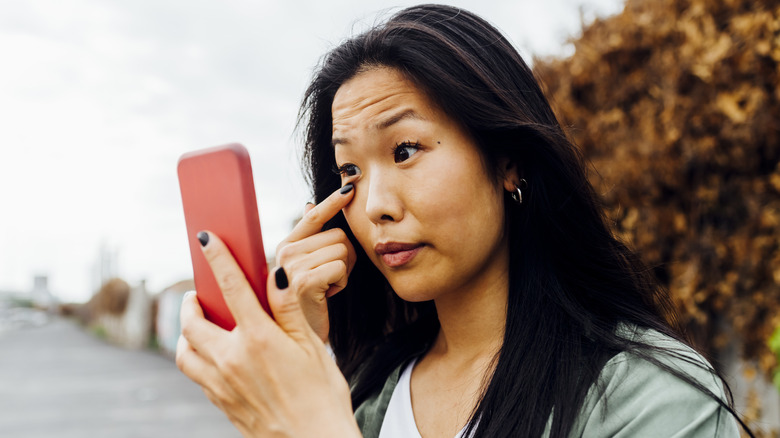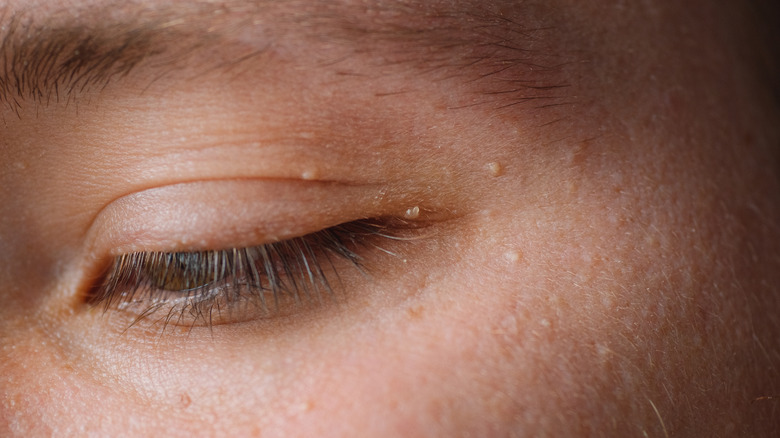The Easy Hack To Prevent Milia Around Your Eyes
We may receive a commission on purchases made from links.
Red-light therapy, Korean sunscreens, double cleansing, and retinol. Do you know what these things have in common? They've all been named in people's routines for having "glass skin." Glass skin is associated with K-beauty, and means that one has skin so radiant that it's as smooth as glass. Clean skin started as a trend but has now become an obsession, and part of achieving that is treating any milia around your eyes. Milia (also known as milk spots) are teeny-tiny white bumps that appear on the face, especially around the eye area. They are usually caused by an overload of keratin in small pockets under the surface of the skin. While they may not be harmful, they can hinder your path to glass skin. So, we're teaching you an easy hack to prevent milia around your eyes.
Whether it's sunglasses or prescription frames, many carry some form of eyewear. But wearing glasses can actually cause milia. Kerry Spindler of Bespoke Aesthetics Spa said "Glasses, particularly those with tight or heavy frames, may contribute to the development of milia." This is because frames can hinder your skin's natural exfoliation process. To prevent this, Spindler highlighted a few steps to take when wearing your frames to prevent milia, like cleaning your glasses regularly to help minimize the transfer of dead skin cells and oils onto your skin, wearing sunscreen daily, and adding a "gentle, non-comedogenic skincare routine to keep pores clear."
There are more hacks to prevent milia from forming
The cause of milia is not limited to wearing glasses. In fact, some individuals may hardly ever wear glasses and still struggle with those little white bumps. Some experts say that individuals who fail to follow a proper skincare routine or use makeup or skincare products that clog pores are more susceptible to developing milia. Additionally, those who suffer from a lack of sleep or have certain skin conditions like eczema are at a higher risk.
Did you know there are different types of milia? There is neonatal milia that are found in infants, there's primary milia, then there's secondary milia which is caused by traumatic skin damage such as sunburns and exposure to sunlight, and the list goes on. However, we're narrowing our focus down to primary and secondary milia as those are milias that we can try and proactively prevent.
On top of cleaning your glasses, wearing sunscreen, and having a non-comedogenic skincare routine, incorporating some sort of exfoliation two to three times a week can help reduce the risk of dead skin cells trapping keratin under the skin's surface. It's also been said that steaming the skin may be an effective way to open your pores and help dislodge keratin buildup.
There are some products you can try to prevent and treat milia
Whether you're trying to prevent milia or already struggling with them, we're here to help. Topical retinoids, chemical peels, and skincare products that contain certain acids have been suggested by skincare experts to treat or get rid of milia. (Also just an FYI, retinol, retinoids, and retinal are all different.)
A Redditor stated her dermatologist recommended glycolic acid and it got rid of her milia in a matter of days. She mentioned using The Ordinary's Glycolic Acid 7% Exfoliating Toner. Dr. Michael Farber, a board-certified dermatologist, told Allure that his favorite product for getting rid of milia was a cleanser — La Roche Posay's Effaclar Medicated gel cleanser.
The sudden appearance of milia can be very stressful, but there's no need to fear. There are so many options available and ultimately, if OTC products are not cutting it, you can always try and schedule a consultation with a dermatologist to discuss prescription-based treatments.


